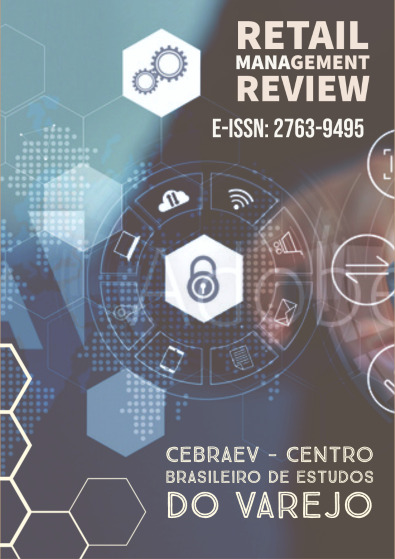Abstract
Objetivo do estudo: caracterizar o efeito do apelo à escassez sobre a intenção de compra.
Metodologia/ abordagem: estudo experimental, single factor, onde a variável apelo de escassez foi manipulada em dois níveis (apelo à escassez versus controle) e a variável dependente intenção de compra foi mensurada.
Principais resultados: consumidores demonstram maior intenção de compra diante do apelo à escassez.
Contribuições teóricas/ metodológicas: os resultados corroboram os achados de estudos anteriores, reafirmando que o apelo à escassez influencia positivamente a intenção de compra.
Relevância/ originalidade: o estudo contribui para o entendimento dos efeitos gerados pelo uso do apelo à escassez sobre o consumidor.
Implicações para a gestão: a utilização do apelo à escassez permanece como uma estratégica eficiente para o aumento na intenção de compra. Assim, gestores podem, com baixo custo, realizar ações que incrementem as vendas de seus negócios.
References
Blackwell, R.D., Miniard, P. W., & Engel, J. F. (2005). Comportamento do consumidor. 9ª ed. São Paulo: Pioneira Thomson Learning.
Brock, T.C., & Brannon L.A. (1992). Liberalization of Commodity Theory, Basic and Applied Social Psychology, 13(1), 135-144.
Castro, I., Morales A., & Nowlis, S. (2013). The Influence of disorganized shelf displays and limited product quantity on consumer purchase. Journal of Marketing, 77(4), 118-133.
Cialdini, R. B. (2009). Influence: Science and practice. 5ª ed. Boston, MA: Pearson education.
Creswell, J.W. (2010). Projeto de pesquisa: métodos qualitativo, quantitativo e misto. 3.ed. Porto Alegre: Artmed.
DeVellis, R. F. (2016). Scale development: Theory and applications (4. ed.). Los Angeles: Sage publications.
Dodds, W. B., Monroe, K. B., & Grewal, D. (1991). Effects of price, brand, and store information on buyers' product evaluations. Journal of marketing research, 307-319
Entman, R.M. (1993). Framing: toward clarification of a fractured paradigma. Journal of Communication, 43(4), 51- 58.
Griskevicius, V., Goldstein, N. J., Mortensen, C. R., Sundie, J. M., Cialdini, R. B., & Kenrick, D. T. (2009). Fear and loving in Las Vegas: Evolution, emotion, and persuasion. Journal of Marketing Research, 46(3), 384-395.
Guha, A., Biswas, A., Grewal, D., Verma, S., Banerjee, S., & Nordfält, J. (2018). Reframing the discount as a comparison against the sale price: does it make the discount more attractive? Journal of Marketing Research, 55(3), 339-351.
Gupta, S., & Gentry, J. W. (2016). The behavioral responses to perceived scarcity–the case of fast fashion. The International Review of Retail, Distribution and Consumer Research, 26(3), 260-271.
Hernandez, J.M.C., Basso, K., & Brandão, M. M. (2014). Pesquisa Experimental em Marketing. Revista Brasileira de Marketing – ReMark, 13(2), 98 – 117.
Jaiswal, D., & Kant, R. (2018). Green purchasing behaviour: A conceptual framework and empirical investigation of Indian consumers. Journal of Retailing and Consumer Services, 41, 60-69.
Kahneman, D., & Tversky, A (1979). Prospect Theory: An Analysis of Decision under Risk. Journal of the Econometric Society - Econometrica, 47(2). 263-291.
Levav, J., & Zhu, R. (2009). “Seeking freedom through variety,” Journal of Consumer Research, 36(4), 600–10.
Lynn, M., & Bogert, P. (1996). The effect of scarcity on anticipated price appreciation. Journal of Applied Social Psychology, 26(22), 1978-1984.
Mirabi, V., Akbariyeh, H., & Tahmasebifard, H. (2015). A study of factors affecting on customers purchase intention. Journal of Multidisciplinary Engineering Science and Technology. 2(1), 267-273.
Mukherjee, A., & Lee, S.Y. (2016). Scarcity appeals in advertising: the moderating role of expectation of scarcity. Journal of Advertising, 45(2), 256-268.
Oruc, R. (2015). The Effects of Product Scarcity on Consumer Behavior: A Meta-Analysis (Doctoral dissertation, Europa-Universität Viadrina Frankfurt).
Schins, M.H.S. (2014). The influence of quantity scarcity and time restrictions on consumer preference and purchase intention. Student Report. Wageningen University, Wageningen, Holanda.
Tversky, A., & Kahneman, D. (1974). Judgment under uncertainty: heuristics and biases. science, 185(4157), 1124-1131.
Zhang, Y., Jing, L., Bai, Q., Shao, W., Feng, Y., Yin, S., & Zhang, M. (2017). Application of an integrated framework to examine Chinese consumers’ purchase intention toward genetically modified food. Food Quality and Preference, 65(1) 118-128

This work is licensed under a Creative Commons Attribution-NonCommercial-ShareAlike 4.0 International License.
Copyright (c) 2021 Retail Management Review





